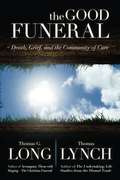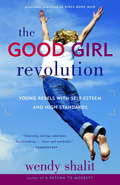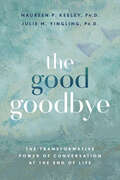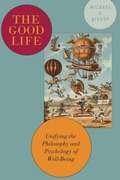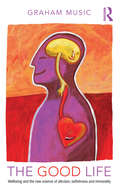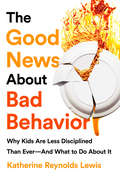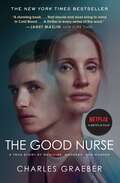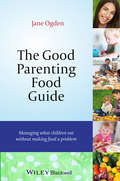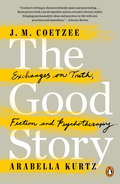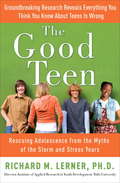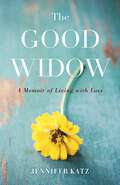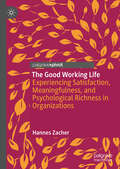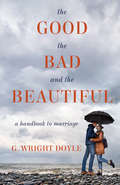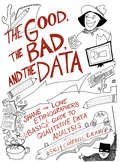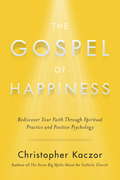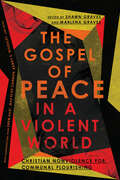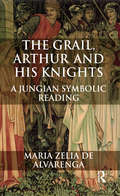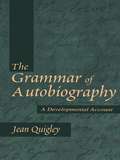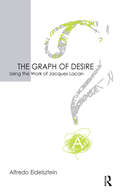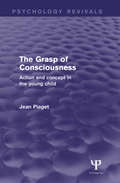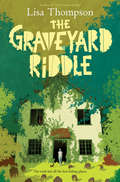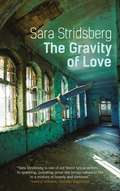- Table View
- List View
The Good Funeral
by Thomas Lynch Thomas G. LongTwo of the most authoritative voices on the funeral industry come together here in one volume to discuss the current state of the funeral. Through their different lenses--one as a preacher and one as a funeral director--Thomas G. Long and Thomas Lynch alternately discuss several challenges facing "the good funeral," including the commercial aspects that have led many to be suspicious of funeral directors, the sometimes tense relationship between pastors and funeral directors, the tendency of modern funerals to exclude the body from the service, and the rapid growth in cremation. The book features forewords from Patrick Lynch, President of the National Funeral Directors Association, and Barbara Brown Taylor, highly praised author and preacher. It is an essential resource for funeral directors, morticians, and pastors, and anyone else interested in current funeral practices.
The Good Girl Revolution
by Wendy ShalitAcross the country, there's a youth-led rebellion challenging the status quo. In Seattle and Pittsburgh, teenage girls protest against companies that sell sleazy clothing. Online, a nineteen-year-old describes her struggles with her mother, who she feels is pressuring her to lose her virginity. In a small town outside Philadelphia, an eleventh-grade girl, upset over a "dirty book" read aloud in English class, takes her case to the school board. These are not your mother's rebels. Drawing on numerous studies and interviews, the brilliant Wendy Shalit makes the case that today's virulent "bad girl" mindset truly oppresses young women. She reveals how the media, one's peers, and even parents can undermine girls' quests for their authentic selves, and explains what it means to break from the herd mentality and choose integrity over popularity. Written with sincerity and upbeat humor, The Good Girl Revolution rescues the good girl from the realm of mythology and old manners guides to show that today' s version is the real rebel. Society may perceive the good girl as "mild," but Shalit demonstrates that she is in fact the opposite. The new female role models are not "people pleasing" or repressed; they are outspoken and reclaiming their individuality. These empowering stories are sure to be an inspiration to teenagers and parents alike. Join the conversation at www.thegoodgirlrevolution.comFrom the Trade Paperback edition.-The Washington Times "A work of art. Wendy Shalit single-handedly transforms the way we view sexuality, and she is outrageously right-on. This is a book celebrating what women truly are and can be: loved, loving, strong, and complex. Shalit is a woman of high intellect, yet her arguments are witty, hip and logically presented (and she is also truly very funny!) making this book accessible and profound for the young and mature reader alike."--Dr. Mayim Bialik, neuroscientist at UCLA and former Blossom star "When Wendy Shalit wrote A Return To Modesty in 1999, she knew which way the cultural winds were blowing. Since that time, the sleaze factor in our culture has worsened in ways about which numbers of people now express dismay. But in this book, Wendy Shalit has documented voices of real girls who are raising important questions about the culture around them. Many of these individual girls are taking action to counter this prevailing culture--putting a new slant on counter-cultural! The Good Girl Revolution profiles girls and young women who think for themselves. They are proud of who and what they are, and are making the choices that will allow them to continue to feel this way." --Dr. Patricia Dalton, clinical psychologist in practice in Washington, D.C."Here we are, decades after the feminist revolution, and yet crude self-display - of a kind that makes the daring of the 1960s seem quaint - is considered something that a "normal" college girl might eagerly choose to do for a stranger with a camera and a release form. What is going on? "We continually malign the good girl as 'repressed,'" notes Wendy Shalit, "while the bad girl is (wrongly) perceived as intrinsically expressing her individuality and somehow proving her sexuality."-The Wall Street Journal, reviewed by Pia Catton"Even-tempered, sweetly reasonable, and full of pleasing glints of dry wit. . . an intelligent, illuminating, and unexpectedly optimistic book about those young women who have chosen to opt out of the revolution."-Contentions, reviewed by Terry Teachout"Charming, moving, sometimes heartbreaking...brave and wonderful." --Commentary". . .throws into detailed, sickening relief the actual content the average girl in North America is subjected to from birth onwards in the determination to make her "bad." . . A solid researcher, citing wide-ranging statistical, professional and anecdotal testimony, Shalit builds a persuasive case for promiscuity's harsher toll on women than men."-The National Post, reviewed by Barbara Kay"The culture has not yet carved out a space for women to indulge thei...
The Good Girl Revolution: Young Rebels with Self-Esteem and High Standards
by Wendy ShalitAcross the country, there’s a youth-led rebellion challenging the status quo. In Seattle and Pittsburgh, teenage girls protest against companies that sell sleazy clothing. Online, a nineteen-year-old describes her struggles with her mother, who she feels is pressuring her to lose her virginity. In a small town outside Philadelphia, an eleventh-grade girl, upset over a “dirty book” read aloud in English class, takes her case to the school board. These are not your mother’s rebels. Drawing on numerous studies and interviews, the brilliant Wendy Shalit makes the case that today’s virulent “bad girl” mindset truly oppresses young women. She reveals how the media, one’s peers, and even parents can undermine girls’ quests for their authentic selves, and explains what it means to break from the herd mentality and choose integrity over popularity. Written with sincerity and upbeat humor, The Good Girl Revolution rescues the good girl from the realm of mythology and old manners guides to show that today’ s version is the real rebel. Society may perceive the good girl as “mild,” but Shalit demonstrates that she is in fact the opposite. The new female role models are not “people pleasing” or repressed; they are outspoken and reclaiming their individuality. These empowering stories are sure to be an inspiration to teenagers and parents alike. Join the conversation at www.thegoodgirlrevolution.comFrom the Trade Paperback edition.
The Good Goodbye: The Transformative Power of Conversation at the End of Life
by Maureen P. Keeley Ph.D Julie M. Yingling Ph.DCommunication experts offer examples and expertise about end-of-life conversations to inspire, teach, and encourage the reader to have their own and to grow from them.Death is one thing we cannot control. We will all face the death of a loved one. And many, if not most, people in our culture will be hesitant and unprepared to say goodbye.The Good Goodbye is meant to help those who must say goodbye to a loved one who is dying. In it, readers will discover how culture affects final conversations, and that often the last interactions may not consist of words but gestures and expressions. They will find examples from real people interviewed over many years, with themes that include love, everyday talk, taking care of business, identity messages, spiritual messages, and healing difficult relationships.Readers will learn about the positive outcomes of final conversations, both from the advice of children and the detailed stories of adults who were changed profoundly in their attitudes and life paths. They will also see that many people have experienced communication with their loved one after that loved one has passed. Finally, readers will discover how others have overcome negativity to engage in the good goodbye, and how they can improve their own preparedness to have final conversations.Anyone who faces the death of a loved one—and that will be all of us—can gain from reading this book. We have found that hospice workers, nurses, caregivers, assisted-living personnel, spiritual advisors, and grief groups are especially interested. But anyone who is walking the path with someone close who is dying will seek this information and enjoy the inspiration.The main message: Be there. Listen. Love. Be grateful for the opportunity to grow.
The Good International Citizen
by David Horner John ConnorVolume 3 of the official history of Australian peacekeeping, humanitarian and post-cold war operations explores Australia's involvement in six overseas missions following the end of the Gulf War: Cambodia (1991–99); Western Sahara (1991–94); the former Yugoslavia (1992–2004); Iraq (1991); Maritime Interception Force operations (1991–99); and the contribution to the inspection of weapons of mass destruction facilities in Iraq (1991–99). These missions reflected the increasing complexity of peacekeeping, as it overlapped with enforcement of sanctions, weapons inspections, humanitarian aid, election monitoring and peace enforcement. Granted full access to all relevant Australian Government records, David Horner and John Connor provide readers with a comprehensive and authoritative account of Australia's peacekeeping operations in Asia, Africa and Europe.
The Good Life: Unifying The Philosophy And Psychology Of Well-being
by Michael A. BishopPhilosophers defend theories of what well-being is but ignore what psychologists have learned about it, while psychologists learn about well-being but lack a theory of what it is. In The Good Life, Michael Bishop brings together these complementary investigations and proposes a powerful, new theory for understanding well-being. The network theory holds that to have well-being is to be "stuck" in a self-perpetuating cycle of positive emotions, attitudes, traits and accomplishments. For someone with well-being, these states - states such as joy and contentment, optimism and adventurousness, extraversion and perseverance,strong relationships, professional success and good health - build upon and foster each other. They form a kind of positive causal network (PCN), so that a person high in well-being finds herself in a positive cycle or "groove. " A person with a lesser degree of well-being might possess only fragments of such a network - some positive feelings, attitudes, traits or successes, but not enough to kick start a full-blown, self-perpetuating network. Although recent years have seen an explosion of psychological research into well-being, this discipline, often called Positive Psychology, has no consensus definition. The network theory provides a new framework for understanding Positive Psychology. When psychologists investigate correlations and causal connections among positive emotions, attitudes, traits, and accomplishments, they are studying the structure of PCNs. And when they identify states that establish, strengthen or extinguish PCNs, they are studying the dynamics of PCNs. Positive Psychology, then, is the study of the structure and dynamics of positive causal networks. The Good Life represents a new, inclusive approach to the study of well-being, an approach committed to the proposition that discovering the nature of well-being requires the knowledge and skills of both the philosopher in her armchair and the scientist in her lab. The resulting theory provides a powerful, unified foundation for future scientific and philosophical investigations into well-being and the good life.
The Good Life: Wellbeing and the new science of altruism, selfishness and immorality
by Graham MusicAre we born selfish or primed to help others? Does stress make people more antisocial? Can we ever be genuinely altruistic? This book explores some of the dilemmas at the heart of being human. Integrating cutting edge studies with in-depth clinical experience, Graham Music synthesizes a wealth of fascinating research into an explanation of altruism, cooperation and generosity and shows how we are primed to turn off the ‘better angels of our nature’ in the face of stress, anxiety and fear. Using fascinating psychological research but rooted in a clinicians understanding of the impact of stress on our moral and pro-social capacities, The Good Life covers topics as diverse as: The role of parenting and family life in shaping how antisocial or pro-social we become How stress, abuse and insecure attachment profoundly undermine empathic and altruistic capacities The relative influence of our genes or environments on becoming big-hearted or coldly psychopathic How our immediate contexts and recent social changes might tilt us towards either selfish or cooperative behaviour This book makes a unique contribution to a subject that is increasingly on people’s minds. It does not shirk complexity, nor suggest easy explanations, but offers a hard look at the evidence in the hope that we can gain some understanding of how a ‘Good Life’ might develop. Often personally challenging, intellectually exhilarating and written with an easily accessible style, The Good Life makes sense of how our moral selves take shape, and shines a light on the roots of goodness and nastiness.
The Good News About Bad Behavior: Why Kids Are Less Disciplined Than EverAnd What to Do About It
by Katherine Reynolds LewisThe current model of parental discipline is as outdated as a rotary phone.Why don't our kids do what we want them to do? Parents often take the blame for misbehavior, but this obscures a broader trend: in our modern, highly connected age, children have less self-control than ever. About half of the current generation of children will develop a mood or behavioral disorder or a substance addiction by age eighteen. Contemporary kids need to learn independence and responsibility, yet our old ideas of punishments and rewards are preventing this from happening.To stem this growing crisis of self-regulation, journalist and parenting expert Katherine Reynolds Lewis articulates what she calls The Apprenticeship Model, a new theory of discipline that centers on learning the art of self-control. Blending new scientific research and powerful individual stories of change, Lewis shows that, if we trust our children to face consequences, they will learn to adapt and moderate their own behavior. She watches as chaotic homes become peaceful, bewildered teachers see progress, and her own family grows and evolves in light of these new ideas. You'll recognize your own family in Lewis's sensitive, realistic stories, and you'll find a path to making everyone in your home more capable, kinder, and happier--including yourself.
The Good Nurse: A True Story of Medicine, Madness, and Murder
by Charles GraeberAfter his December 2003 arrest, registered nurse Charlie Cullen was quickly dubbed "The Angel of Death" by the media. But Cullen was no mercy killer, nor was he a simple monster. He was a favorite son, husband, beloved father, best friend, and celebrated caregiver. Implicated in the deaths of as many as 300 patients, he was also perhaps the most prolific serial killer in American history. Cullen's murderous career in the world's most trusted profession spanned sixteen years and nine hospitals across New Jersey and Pennsylvania. When, in March of 2006, Charles Cullen was marched from his final sentencing in an Allentown, Pennsylvania, courthouse into a waiting police van, it seemed certain that the chilling secrets of his life, career, and capture would disappear with him. <p><p> Now, in a riveting piece of investigative journalism nearly ten years in the making, journalist Charles Graeber presents the whole story for the first time. Based on hundreds of pages of previously unseen police records, interviews, wire-tap recordings and videotapes, as well as exclusive jailhouse conversations with Cullen himself and the confidential informant who helped bring him down, THE GOOD NURSE weaves an urgent, terrifying tale of murder, friendship, and betrayal. Graeber's portrait of Cullen depicts a surprisingly intelligent and complicated young man whose promising career was overwhelmed by his compulsion to kill, and whose shy demeanor masked a twisted interior life hidden even to his family and friends. <p><p> Were it not for the hardboiled, unrelenting work of two former Newark homicide detectives racing to put together the pieces of Cullen's professional past, and a fellow nurse willing to put everything at risk, including her job and the safety of her children, there's no telling how many more lives could have been lost. In the tradition of In Cold Blood, THE GOOD NURSE does more than chronicle Cullen's deadly career and the breathless efforts to stop him; it paints an incredibly vivid portrait of madness and offers a penetrating look inside America's medical system. Harrowing and irresistibly paced, this book will make you look at medicine, hospitals, and the people who work in them, in an entirely different way.
The Good Parenting Food Guide: Managing What Children Eat Without Making Food a Problem
by Jane OgdenThe Good Parenting Food Guide offers straightforward advice for how to encourage children to develop a healthy, unproblematic approach to eating. Explores key aspects of children’s eating behavior, including how children learn to like food, the role of food in their life and how habits are formed and can be changed Discusses common problems with children’s diets, including picky eating, under-eating, overeating, obesity, eating disorders and how to deal with a child who is critical of how they look Turns current research and data into practical tips Filled with practical solutions, take home points, drawings, and photos Mumsnet Blue Badge Award Winner
The Good Story
by J. M. Coetzee Arabella KurtzA fascinating dialogue on the human desire to make up stories between Nobel Prize-winning author J. M. Coetzee and psychotherapist Arabella Kurtz The Good Story is an exchange between a writer with a long-standing interest in moral psychology and a psychotherapist with training in literary studies. Coetzee and Kurtz consider psychotherapy and its wider social context from different perspectives, but at the heart of both their approaches is a fascination with narrative. Working alone, the writer is in control of the story he or she tells. The therapist, on the other hand, collaborates with the patient in telling the story that might reveal the "truth." The authors discuss both individual psychology and the psychology of the group: the school classroom, the gang, the settler nation in which the brutal deeds of the ancestors must be accommodated into a national story. In a meeting of the minds that is illuminating, surprising, and thought provoking, Coetzee and Kurtz explore the human capacity for self-examination--our attempts to understand our own individual life stories as well as our part in the larger story through language.
The Good Story: Exchanges on Truth, Fiction and Psychotherapy
by J. M. Coetzee Arabella KurtzJ.M. Coetzee: What relationship do I have with my life history? Am I its conscious author, or should I think of myself as simply a voice uttering with as little interference as possible a stream of words welling up from my interior?Arabella Kurtz: One way of thinking about psychoanalysis is to say that it is aimed at setting free the narrative or autobiographical imagination.The Good Story is a fascinating dialogue about psychotherapy and the art of storytelling between a writer with a long-standing interest in moral psychology and a psychotherapist with training in literary studies. Coetzee and Kurtz consider psychotherapy and its wider social context from different perspectives, but at the heart of both of their approaches is a concern with narrative. Working alone, the writer is in control of the story he or she tells. The therapist, on the other hand, collaborates with the patient in developing an account of the patient's life and identity that is both meaningful and true.In a meeting of minds that is illuminating and thought-provoking, the authors discuss both individual psychology and the psychology of the group: the school classroom, gangs and the settler nation, in which the brutal deeds of ancestors are accommodated into a national story. Drawing on great writers like Cervantes and Dostoevsky and psychoanalysts like Freud and Melanie Klein, Coetzee and Kurtz explore the human capacity for self-examination, our wish to tell our own life stories and the resistances we encounter along the way.J.M. Coetzee's latest novel, The Schooldays of Jesus, will soon be available from Viking.From the Hardcover edition.
The Good Teen
by Richard M. Lerner Roberta IsraeloffFor many parents the thought of the teen years holds more dread than all the sleepless nights of infancy and scraped knees of childhood combined. After all, teens are obstinate, inconsiderate, and defiant; they sulk and stress; they are prone to bad decisions and unreasonable behavior. Given the option, most parents would happily skip the storms of adolescence and move right in to the relative calm of young adulthood if they could. Who can blame them when popular wisdom tells them that their lovable twelve-year-old will be replaced by an unpredictable, emotional volcano at the age of thirteen? Although the word teenager has become synonymous with trouble, the evidence is clear: Adolescents have a bad rap—and according to groundbreaking new research, it’s an undeserved one. InThe Good Teen, Richard Lerner lays bare compelling new data on the lives of teens today, dismantling old myths and redefining normal adolescence. Time and again his work reveals that in spite of the stereotypes, today’s teens are basically good kids who maintain healthy relationships with their families. Overflowing with real-life anecdotes and cutting-edge science,The Good Teenencourages new thinking, new public policies, and new programs that focus on teens’ strengths. Every teen, whatever their ability or background, has the same potential for healthy and successful development. InThe Good Teen, Lerner presents the five personality characteristics, called the 5 Cs, that are proven to fuel positive development: Competence, Confidence, Connection, Character, and Caring. When the 5 Cs coalesce, a sixth emerges, Contribution: where young people contribute to their own development in an energetic and optimistic way. He also prescribes specific ways parents can foster the 5 Cs at home and in their communities.
The Good Widow: A Memoir of Living with Loss
by Jennifer KatzWhat do we do when life ends? How do we honor the past while moving into an unimaginable, uncertain future? This tender, bracingly honest memoir explores how Jenny, a young widow, navigates the sudden loss of Tris, her beloved spouse of eighteen years.With Tris gone, Jenny suddenly finds herself a single mom to a teen daughter and adult stepson. The newly splintered family finds ways to celebrate &“milestone firsts&” —including birthdays and other holidays that, without Tris, now feel hollow and bittersweet. Jenny finds herself drawn to new people, including other widows and psychic mediums, and becoming open to different kinds of connections based on sharing and spirituality. She also embarks on a halting quest for new romantic love. Initially, as she endures awkward first dates and unpleasant interactions with self-proclaimed &“nice guys,&” she resists her new reality —but over time, she finds someone unexpectedly comforting, blending the pain of loss with the pleasure of closeness. For readers who have also lost a loved one, The Good Widow offers both a comforting guide to grief and a form of companionship; for everyone, it&’s a beautiful example of how even after death, love endures.
The Good Working Life: Experiencing Satisfaction, Meaningfulness, and Psychological Richness in Organizations
by Hannes ZacherThis book adapts the ancient philosophical notion of the “good life” to the context of modern work and organizations. It outlines a vision of the good working life as the simultaneous experience of high levels of job satisfaction, work meaningfulness, and work psychological richness. In the chapters, these three dimensions of the good working life are related to various individual differences, such as demographic and personality characteristics, as well as different work characteristics, including job demands and job resources. The three dimensions of the good working life are also analysed across different industries, and differentially related to important work outcomes, such as job engagement, performance, and occupational health, as well as key life outcomes, including life satisfaction, health, societal contributions, and wisdom. Promoting a positive psychological perspective on work, this book offers a compelling read for academics, students, and practitioners interested in improving employee wellbeing and reducing stress in organizations.
The Good, the Bad, and the Beautiful: A Handbook to Marriage
by Wright DoyleObstacles and challenges are a normal part of married life. Here’s how you get through them.This book will lead you to understand what happens when two people tie the proverbial knot. The trials and obstacles that inevitably follow are nothing unusual—how they are handled is what helps distinguish a successful marriage from an unsuccessful one.Specific advice about handling finances, keeping house, sexual relations, bringing up children, and other very important matters will not be found here. Instead, The Good, The Bad, and The Beautiful focuses on the relationship between husband and wife, for from this flows the motivation, energy, and wisdom to deal with the problems and challenges facing married couples. Unless you make this relationship your main concern, all your efforts in other areas of married life will be out of balance and ultimately unsuccessful.If you are seeking a successful and fulfilling marriage, or the restoration of a failing one, you will find meaning and hope in the joys of learning and practicing God's blessed plan for husband and wife.
The Good, the Bad, and the Data: Shane the Lone Ethnographer’s Basic Guide to Qualitative Data Analysis
by Sally Campbell PirieData analysis is often the most difficult task facing students and novice qualitative researchers, including Shane the Lone Ethnographer—a grad student with fond visions of the Wild West—and her horse Transcriptor. In this comic-style textbook, we follow Shane as she attempts to corral her data and make sense of it for publication. Shane learns how to read, sort, code, write, and assess the analysis of a qualitative study in the traditions of ethnography, grounded theory, discourse, and narrative analysis. Along the trail, she receives helpful advice from experienced researchers who explain their analytic practices in detail. Written in a friendly, comic book style, Shane’s Wild West adventures in data analysis will be both instructive and an enjoyable read.
The Gospel of Happiness
by Christopher KaczorWhat is true happiness? How can you experience it? And can you live it wholeheartedly in your day-to-day life? Every thoughtful person asks such questions. Thoughtful Christians ask a few more questions such as, Can Christian practices enhance happiness? If so, how? And does Christianity provide happiness in a way that other paths, like psychology, cannot? Christopher Kaczor suggests answers to these and other questions about how to be happier. In The Gospel of Happiness, the bestselling author of The Seven Big Myths of the Catholic Church highlights seven ways in which positive psychology and Christian practice can lead to personal and spiritual transformation. Focusing on empirical findings in positive psychology that point to the wisdom of many Christian practices and teachings, the author provides not only practical suggestions on how to become happier in everyday life but provides insight on how to deepen Christian practice and increase love of God and neighbor in new and bold ways."Part of the Christian message is that authentic happiness is to be found not in selfishness, but self-giving," writes Dr. Kaczor. "In this book, I highlight the many ways in which positive psychology and Christian practice overlap. All of this points us toward deeper fulfillment in this life, and in the life to come."
The Gospel of Peace in a Violent World: Christian Nonviolence for Communal Flourishing
by Marlena Graves Marlena Graves, Shawn Graves Shawn Graves"Blessed are the peacemakers."The gospel of Jesus Christ is the good news of peace: peace between God and humanity, peace among humans. And yet it can be difficult to see that peace in our broken, violent world.shalomMay it be so.
The Grail, Arthur and his Knights: A Jungian Symbolic Reading
by Maria Zelia de AlvarengaThis book presents a broad and deep symbolic reading of the characters involved in the mythical Holy Grail. It discusses on Arthur and his loyal and faithful knights; the wise old Merlin and his visions of the future; the archetypical themes of quest and the desire to return to the golden age.
The Grammar of Autobiography: A Developmental Account
by Jean QuigleyThis is the first book to bring together four distinct literatures--functional linguistics, child language, narrative development, and discursive psychology. It is an outgrowth of the historical relationship between psychology and linguistics, especially the post-Wittgensteinian "turn to language." Relevant issues are situated at that interface in a way that should prove accessible to both linguists with little or no psychological knowledge and to psychologists with no linguistics background are addressed. Previously, there have been volumes on the theses of discursive psychology and social constructionism and volumes on the workings and theories of functional linguistics, but none have attempted to link the two as natural bedfellows in this way. While clearly situated within the spirit of the Berkeley school, it goes beyond it by virtue of linking functional linguistics and discursive psychology, and by doing this ontogenetically. Overall, this book is an investigation of the psycholinguistic thesis of the social construction of selfhood and the psychology of everyday life. Featuring the only book-length studies of the use of grammatical analysis as a research strategy in psychology, it integrates issues of human development and child language in a new way. It deals in careful linguistic analyses, examining the role of grammatical forms in constituting context which involves an examination of their functions that are then used to highlight fundamental aspects of development. The linguistic analyses are treated as a testing ground for the ideas and claims made in discursive psychology. The discussion deals with many of the current issues in psychology and related disciplines, including narrative, morality, agency, and responsibility, in order to show the central role of language in human functioning.
The Graph of Desire: Using the Work of Jacques Lacan
by Alfredo EidelszteinThe 'graph of desire' is one of the principal points of reference in Lacanian psychoanalysis. In this book the graph is analyzed in its multiple aspects and relations. Step by step, the author reveals and considers formulations from the simplest to the most complex. The treatment of this issue does not deal only with the development and explanation of its logical, mathematical and topological aspects but also goes through the psychoanalytical theory and practice. The author has immersed himself in Lacan's text "The Subversion of the Subject and the Dialectic of Desire in the Freudian Unconscious" to uncover and bring this fascinating subject to light.
The Grasp of Consciousness: Action and Concept in the Young Child (Psychology Revivals)
by Jean PiagetOriginally published in English in 1976, the book draws on and extends our knowledge of the process of learning. The subject of the study is the general stage in a child’s development that comes between his successful performance of an activity without knowing how he did it – that is, what he had to do in order to succeed – and the times when he becomes aware of what went into that action. The book reports the results of experiments conducted at the Centre of Genetic Epistemology. Children, ranging in age between four and adolescence, were asked to perform such tasks as walking on all fours, playing tiddlywinks, building a ramp for a toy car. They were then asked to explain how they had performed the task, and in some cases, to instruct the interviewer. Their answers show a number of surprising inaccuracies in the child’s ability to grasp the nature of what he has done. Taking a broad view of his results, Piaget shows that they reveal several stages in the gradual development of the child’s conceptualization of his actions. In analysing each stage, Piaget argues that the child’s concept of his own action cannot be considered a simple matter of ‘enlightenment’, but must actively be reconstructed from his experience. This view has always been at the core of Piaget’s work, and a new area of the child’s mental world is here given definitive treatment.
The Graveyard Riddle: A Goldfish Boy Novel
by Lisa ThompsonLisa Thompson returns to the world of The Goldfish Boy in her new novel.Melody Bird has discovered an abandoned old building in the corner of the graveyard...Though it's dark and creepy, she can't resist its pull. When she goes to explore, she finds a mysterious boy hiding out there. Hal tells Melody that he's a spy, using the house as a base for his undercover surveillance of a nearby suspected criminal. He's very secretive about the details, but Melody comes to trust him and starts helping him with his mission.Melody is determined to decode the strange riddles Hal finds hidden in the graveyard, but her friends Matthew and Jake question Hal's story. They decide to turn the tables and find out the truth about him, uncovering the biggest mystery of all...This extraordinary novel set in the world of The Goldfish Boy is a page-turning mystery with a sensitive story about friendship and trust at its core.
The Gravity of Love
by Sara StridsbergA dazzlingly inventive and acclaimed novel set in a Stockholm psychiatric hospital - by one of Sweden's most exciting literary talents"I'll put my head in the oven so you know where I am," he whispers, kissing her neck.Jim - charming, captivating, much loved by his women friends - has attempted suicide several times. Over his period of incarceration at the Beckomberga hospital for the mentally unstable, he voices his determination to succeed. Some day soon, he tells his daughter - as he has earlier told his mother and his wife - he will swallow sixty tablets, help them down with a bottle of whisky, and swim impossibly far out into the Atlantic.Will he, really? This question plagues Jim's daughter, the narrator of this powerful novel, who is as addicted to the hospital as her father is to alcohol. Through her subtle observations we understand the emotional needs of diehard alcoholics, the rationally uxoricidal, and other seemingly normal inhabitants of a psychiatric unit in the process of shutting down, depriving them of the only place they have known as home.A Magic Mountain for our times, for readers of Eimear McBride and Alexander Masters.Translated from the Swedish by Deborah Bragan-Turner
